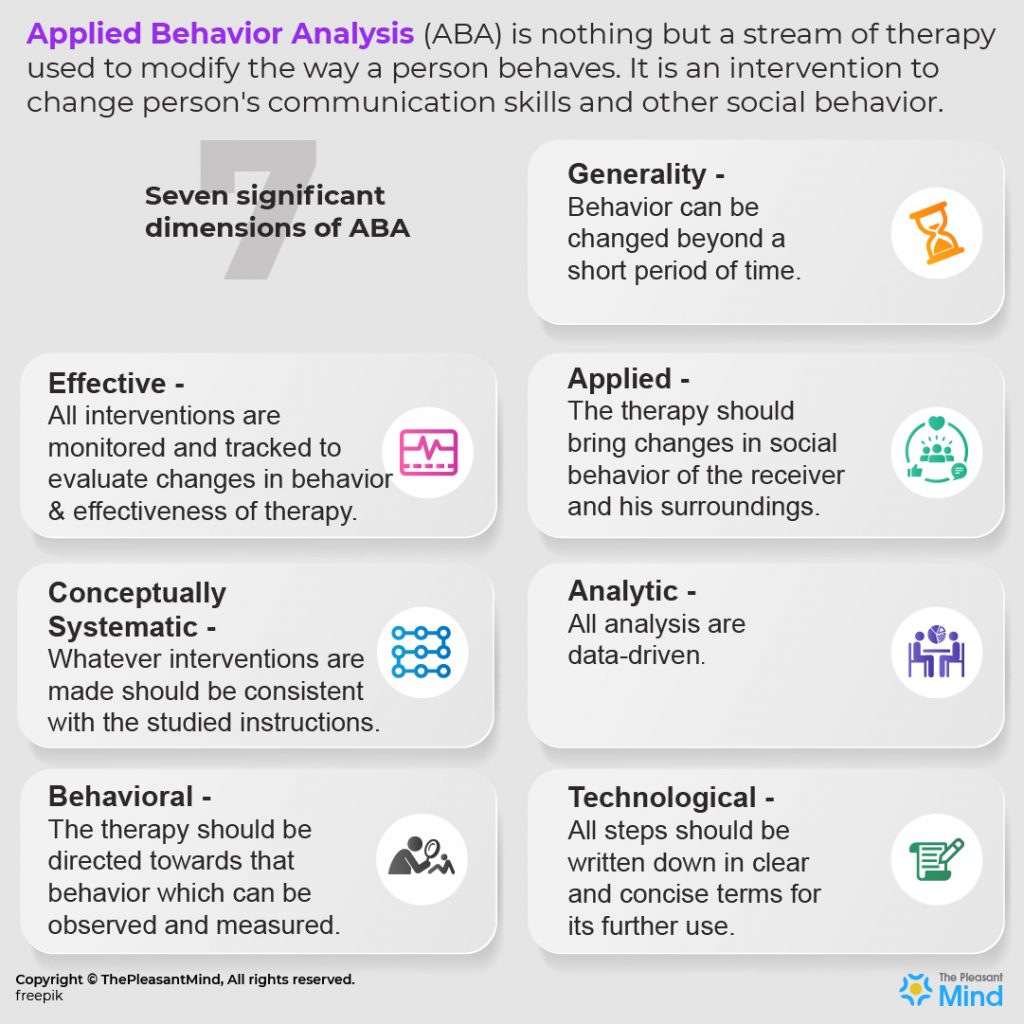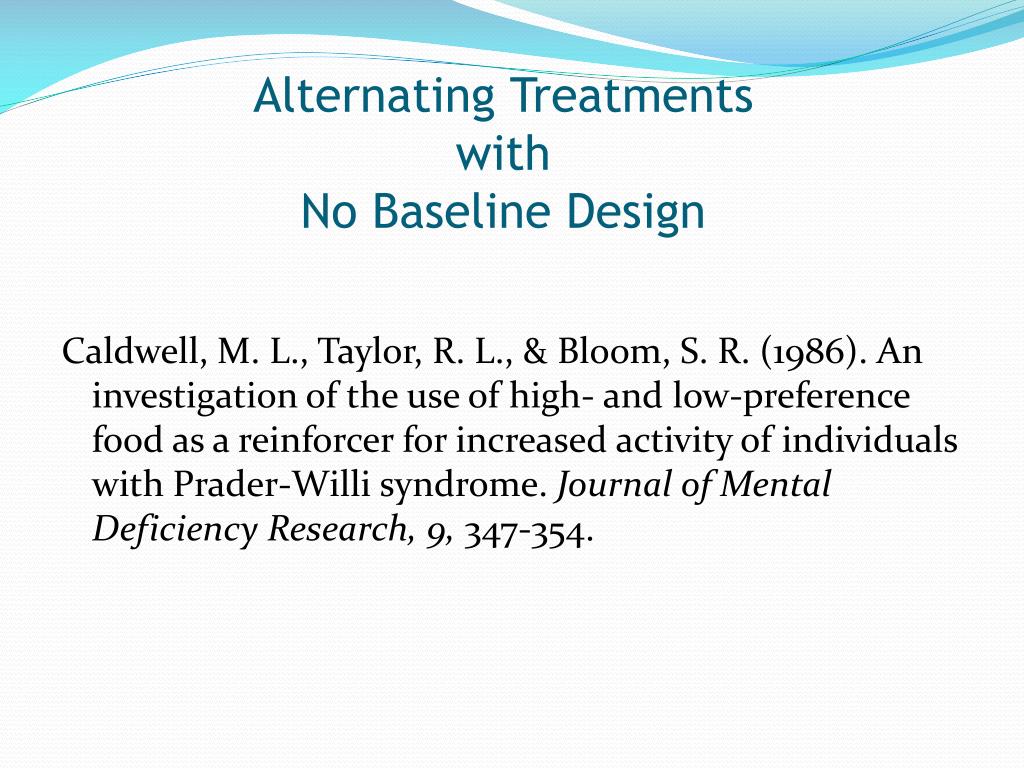Table Of Content

As a result, it is not appropriate to comment on the relative effects of the interventions (i.e., the “B” and “C” phases) in an ABACAC study because they never occur next to one another. Rather, one can only conclude that one, both, or neither intervention is effective relative to baseline. On the other hand, beginning with a full reversal or withdrawal design (ABAB), with it followed by a demonstration of the effects of the second intervention (CAC, resulting in ABABCAC), allows for the direct comparison of the two interventions.
Screen Process and Study Selection
Nonparametric statistical tests for single-case systematic and randomized ABAB…AB and alternating treatment ... - ScienceDirect.com
Nonparametric statistical tests for single-case systematic and randomized ABAB…AB and alternating treatment ....
Posted: Wed, 27 Dec 2017 00:58:04 GMT [source]
The data from the baseline phase established that the participant did not respond correctly in the absence of the intervention. The data from the alternating treatments phase supported the effectiveness of the directed rehearsal and directed rehearsal plus positive reinforcement conditions compared with the control condition. They also supported the relative effectiveness of the directed rehearsal with reinforcement compared with directed rehearsal alone. Multiple-baseline and multiple-probe designs are appropriate for answering research questions regarding the effects of a single intervention or independent variable across three or more individuals, behaviors, stimuli, or settings.
Predictors of Patient Adaptive Behavior Outcomes
When observing outcome measures by age group (see Appendix 5, Table S4), among study records conducted with participants between ages 0–5 years, cognitive, language, and social/communication were the most commonly studied outcomes, at 22%, 23%, and 23% respectively. Meanwhile, for ages 6–12, problem behavior and language were the most commonly studied outcomes at 25% each. For ages 13–18, the most commonly studied outcome was cognitive (26%), followed by adaptive behavior (20%).
Desirable Qualities of Baseline Data
The way in which the effects are replicated depends on the specific experimental design implemented. For many designs, each time the intervention is implemented (or withdrawn following an initial intervention phase), an opportunity to provide an instance of effect replication is created. The alternating treatments design which is increasingly being used in single subject research is described. This design allows the differential effectiveness of two or more treatments to be investigated by presenting each of them separately in closely spaced sessions, with the order of presentation alternated. Consideration is given to the types of behavior and contexts that are most appropriate for use with this design and also to factors important for ensuring its effectiveness and the valid interpretation of the resulting data.
These stimuli were presented in isolation; it is possible that when presented in a hierarchy, such as from most intrusive to least intrusive (e.g., from full physical to gestural), transfer of stimulus control is achieved. Last, such a formal prompt topography assessment might not be needed in clinical settings, if program development is designed by a clinician who is familiar with the learner’s skills and deficits. For example, if the clinician observes that the learner is typically not able to respond correctly to model prompts, she might use other stimulus topographies as prompts and set a separate goal for physical imitation, so that the learner ultimately can respond to imitative prompts as well. A prompt topography assessment was conducted to identify prompt topographies that evoked correct responding. Ten one-step directions were selected from Teaching language to children with autism or other developmental disorders (Sundberg & Partington 1998). As such, three variations of physical prompts (i.e., partial physical(s) and full physical) were included in this assessment.
Articles from the original search of online databases were exported to Mendeley® Desktop versions 1.19–2.62.0, a reference management software, where most duplicate studies were automatically identified and removed. Any remaining duplicates from both the database and review search were removed manually. Titles and abstracts of all retrieved articles were then independently reviewed by two researchers following the outlined inclusion and exclusion criteria. Studies were included if the independent reviewers reached agreement, or after further discussion with a third reviewer. Retained articles then underwent full text review for inclusion, following the same steps. Inclusion criteria for article selection during the initial search comprised (1) English language articles that are (2) about the effects of ABA on (3) children and youth (birth to 18 years) with NDD/D, within (4) the timeframe of January 1, 1997 through December 31, 2020.

If the multiple baselines are being conducted across behaviors, those behaviors must be similar in function, topography, and the effort required to produce them while remaining independent of one another. When selecting conditions for a multiple-baseline (or multiple-probe) design, it is important to consider both the independence and equivalence of the conditions. Independence means that changing behavior in one condition will not affect performance in the others. If the conditions are not independent, implementing the intervention in one condition may lead to changes in behavior in another condition while it remains in the baseline phase (McReynolds & Kearns, 1983).

Alternating treatments design: one strategy for comparing the effects of two treatments in a single subject.
Study records with 5 to 9 participants accounted for 11% of the total and 13% had more than 10 participants. The median number of participants was 3, whereas the mean number of participants was 8.12. In addition, some qualitative characteristics were explored as well, such as observations about the types of methods used in the interventions encountered, the degree of mastery and generalization measures, and how targeted the interventions and measurement tools were.
Prompt Topography Assessment
The authors concluded that the MTL procedure might have delayed learning, but it resulted in fewer errors. Green (2001) stated that minimizing the number of errors is crucial for avoiding the development of faulty stimulus control. Accordingly, to accelerate learning with MTL prompting while keeping the number of errors at minimum, the authors incorporated a 2-s time delay between the presentation of the natural discriminative stimulus and the prompt (Libby et al. 2008). During the 2-s delay, the participants had the opportunity to respond independently, which resulted in skipping prompt-fading steps when a participant made independent correct responses. In the second experiment, the interventionists compared MTL prompting with and without the 2-s time delay. The results confirmed that the MTL procedure with a 2-s time delay was more efficient in terms of trials to criterion while maintaining minimal errors to criterion.
In contrast, the reversal design requires the active reversal of the intervention conditions. For example, reinforcement is provided contingent on the occurrence of a response incompatible with the response reinforced during the intervention (B) phases (see Barlow, Nock, & Hersen, 2009, for a complete discussion of the mechanics and relative advantages of reversal designs). The results from a functional analysis are graphed using an alternating treatments design. Numerous meta-analyses, systematic reviews, and cost benefit analyses testify to the effectiveness of interventions based on applied behaviour analysis (ABA). Despite the progress made by both the autism advocacy and scientific communities, controversy and division remain among researchers, clinicians, and within the autism community. Multiple baseline across participants is done by having multiple participants in the study and staggering when the intervention is applied.
Within the current cohort, out of the study records that signified some improvement, the frequency of mastery/criterion measures varied. Measures of mastery/criterion ranged from 0% and 14%, respectively, for autism symptoms and problem behavior improved outcomes, to 25% and 29%, respectively, for adaptive behavior and social/communication, and 43%–49% for cognitive, language, and emotional improved outcomes (Table S7). With regard to generalization, no study records showing improvements in autism symptoms assessed any measure of generalization. Among other outcomes, generalization measures ranged from 14% for emotional improved outcomes, 24%–29% for problem behavior, adaptive behavior, and cognitive improved outcomes, and 39% and 46%, respectively, for language and social/communication improved outcomes (Table S7). Figure Figure44 depicts the data for the comparison of prompt-fading procedures with Sean. Maintenance sessions were conducted, with accuracy ranging from 70 to 100 % correct responding.




